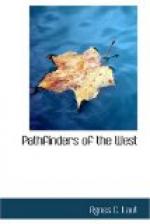[15] This claim will, I know, stagger preconceived ideas. In the light of only Radisson’s narrative, the third voyage has usually been identified with Wisconsin and Minnesota; but in the light of the Jesuit Relations, written the year that Radisson returned, to what tribes could the descriptions apply? Even Parkman’s footnote acknowledged that Radisson was among the people of the Missouri. Grant that, and the question arises, What people on the Missouri answer the description? The Indians of the far west use not only coal for fire, but raw galena to make bullets for their guns. In fact, it was that practice of the tribes of Idaho that led prospectors to find the Blue Bell Mine of Kootenay. Granting that the Jesuit account—which was of course, from hearsay—mistook the use of turf, dry grass, or buffalo refuse for a kind of coal, the fact remains that only the very far western tribes had this custom.
[16] Letters of Marie de l’Incarnation.
[17] Jesuit Relations, 1658.
[18] See Marie de l’Incarnation, Dollier de Casson, and Abbe Belmont.
[19] Jesuit Relations, 1660.
[20] It may be well to state as nearly as possible exactly what tribes Radisson had met in this trip. Those rejoined on the way up at Manitoulin Island were refugee Hurons and Ottawas. From the Hurons, Ottawas, and Algonquins of Green Bay, Radisson went west with Pottowatomies, from them to the Escotecke or Sioux of the Fire, namely a branch of the Mascoutins. From these Wisconsin Mascoutins, he learns of the Nadoneceroron, or Sioux proper, and of the Christinos or Crees. Going west with the Mascoutins, he comes to “sedentary” tribes. Are these the Mandans? He compares this country to Italy. From them he hears of white men, that he thinks may be Spaniards. This tribe is at bitter war with Sioux and Crees. At Green Bay he hears of the Sautaux in war with Crees. His description of buffalo hunts among the Sioux tallies exactly with the Pembina hunts of a later day. Oldmixon says that it was from Crees and Assiniboines visiting at Green Bay that Radisson learned of a way overland to the great game country of Hudson Bay.
[21] There is a mistake in Radisson’s account here, which is easily checked by contemporaneous accounts of Marie de l’Incarnation and Dollier de Casson. Radisson describes Dollard’s fight during his fourth trip in 1664, when it is quite plain that he means 1660. The fight has been so thoroughly described by Mr. Parkman, who drew his material from the two authorities mentioned, and the Jesuit Relations that I do not give it in detail. I give a brief account of Radisson’s description of the tragedy.




